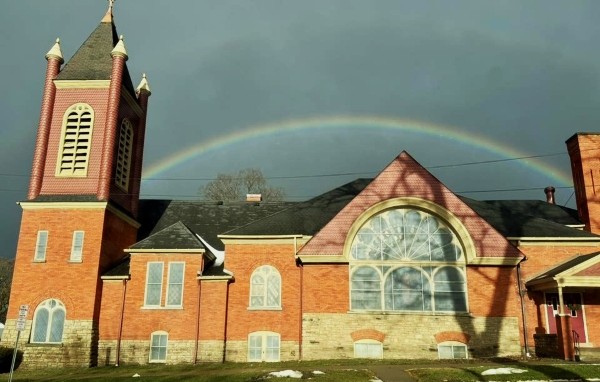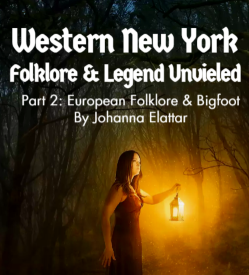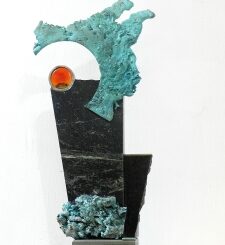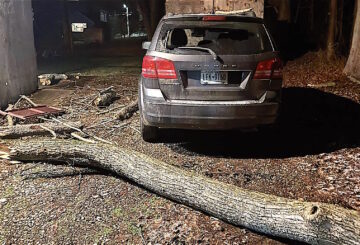“In 1869, a wild man was seen by over a hundred residents in Steuben County”
By: Johanna Elattar
When the first European settlers arrived in what is now New York State, they brought with them not only their tools, customs, and traditions but also a rich tapestry of mythical beliefs. Among these were tales of the “wild man,” a creature thought to inhabit the darker parts of the European countryside. Known variously as the woodwose, wooser, or the “wild man of the woods,” this figure featured prominently in medieval European folklore and art, often depicted as a hairy, beastly figure lurking on the fringes of civilization.
The notion of the wild man persisted in European consciousness from the 13th to the 15th centuries, finding its way into coats-of-arms and literary works. Initially, these wild men were thought to be reclusive humans who had regressed into a feral state, living off the land like animals. Over time, the wild man’s image morphed into something more sinister and less human, reflecting societal anxieties about the wilderness and the unknown.
It is no surprise, then, that the early European pioneers of New York State reported their own encounters with wild men. These accounts often described hermits or mentally ill individuals whose unkempt appearances led to the belief that they had devolved into a feral state. The first documented sighting in New York occurred in 1818 near Ellisburg, close to the Canadian border, when a respectable gentleman reported seeing a hair-covered figure dashing through the woods. Despite a massive search involving hundreds of residents, the creature was never found.
Two decades later, in 1838, a boy in Silver Lake, Pennsylvania, near the New York border, encountered a small, hairy creature that looked like a human child but was covered in black hair. This pattern of sightings continued throughout the 19th century, with numerous reports of wild men in various parts of New York State. In 1869, a wild man was seen by over a hundred residents in Steuben County, who described it as a beastly figure with matted hair, a wild beard, and bloodshot eyes. Later that year, another wild man was spotted near Ogdensburg, with observers noting its long hair-covered limbs.
The most dramatic shift in wild man sightings occurred towards the end of the 19th century when descriptions began to include ape-like characteristics. In 1895, in the Delaware County resort town of Margaretville, a creature described as a “wild-eyed man or ape” with long, hairy arms attacked a team of horses. The creature was said to be seven feet tall, covered in hair, and capable of immense strength. Similarly, in 1899, a gorilla-like wild man was reported in Johnsonburg, Wyoming County, leading to widespread alarm and a hunt for the creature.
As the 20th century progressed, sightings of wild men evolved further into the realm of the fantastical. Reports began to describe creatures more akin to the modern-day Bigfoot—hulking, hair-covered beings often standing around seven feet tall. These creatures were frequently seen in rural areas and occasionally in the suburbs of New York City. Despite numerous reports, no physical evidence or captured creatures were ever produced, leading to a proliferation of theories and a burgeoning interest in the phenomenon.
The Kinderhook Creature, for instance, became a local legend in the late 1970s and early 1980s, with multiple sightings reported by residents. One notable incident involved a grandmother and her relatives encountering a large, hairy creature that made terrifying noises before disappearing into the night. Other reports described similar creatures rummaging through trash cans or confronting terrified locals on desolate roads.
In the early 1980s, even law enforcement officers in Whitehall, New York, reported encounters with massive, hair-covered humanoids. Officer Dan Gordon, in particular, recounted seeing a creature that moved with incredible speed and agility, resembling an ape with slumped shoulders and long swinging arms. Such accounts contributed to a growing body of folklore surrounding these mysterious beings.
By the turn of the 21st century, the image of the wild man had been almost entirely supplanted by that of Bigfoot. Reports of hulking, hair-covered creatures dominated the Bigfoot landscape, with sightings becoming increasingly fantastical. Some modern reports even describe Bigfoot in connection with UFOs or possessing supernatural abilities, reflecting a broader cultural fascination with the paranormal.
Anthropologists and folklorists suggest that the persistence of Bigfoot sightings in contemporary times represents a form of living folklore, providing insight into societal attitudes and anxieties. According to Ernestine McHugh, a cultural anthropologist from Rochester, the fascination with Bigfoot reflects a longing for the magical and the uncanny in an increasingly rational and secular world. Peter Dendle, another scholar, posits that the search for Bigfoot symbolizes a quest for mystery and wonder in a world perceived as having lost its mystique.
Bigfoot enthusiasts often view the creature as a symbol of resistance against unchecked scientific progress and environmental degradation. Some even attribute environmental messages to Bigfoot, reflecting broader concerns about global warming and societal conflicts.
Whether real or imaginary, the study of wild men and Bigfoot is a legitimate and intriguing aspect of our social and cultural history. These reports, evolving over centuries, offer a unique lens through which to view the changing conditions of life in New York State and the enduring human fascination with the unknown. As folklore continues to grow and adapt, so too does the legend of the wild man, ensuring its place in the tapestry of American mythology.







